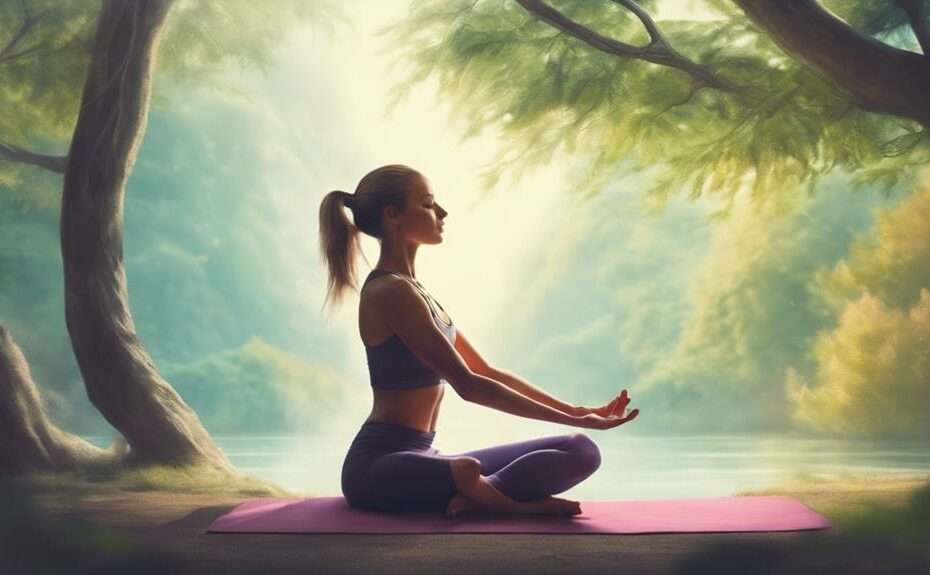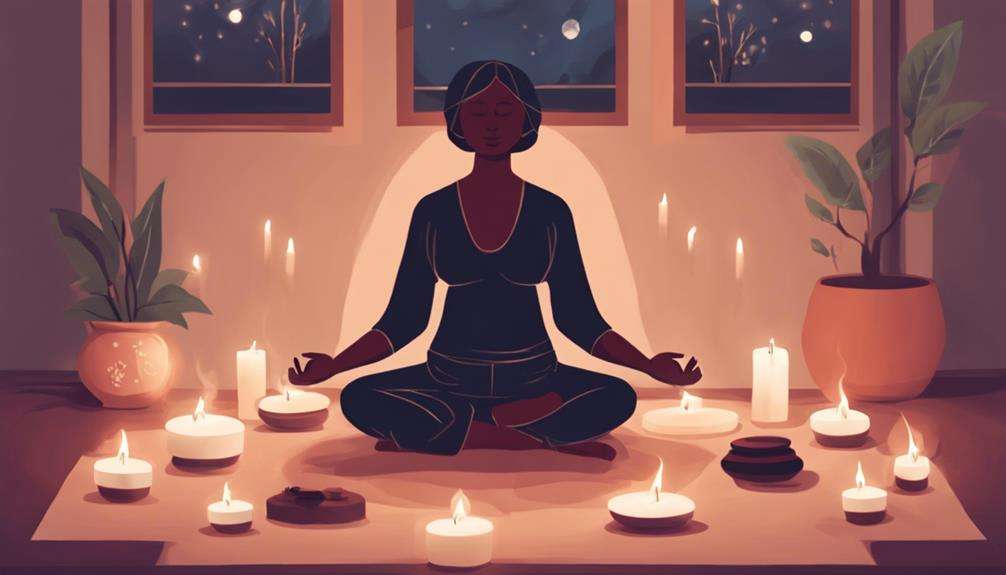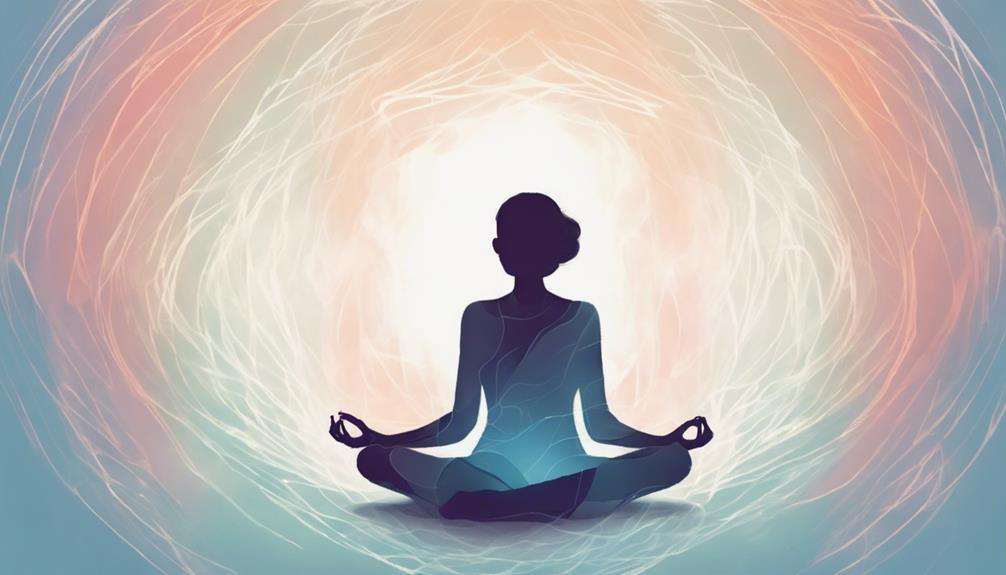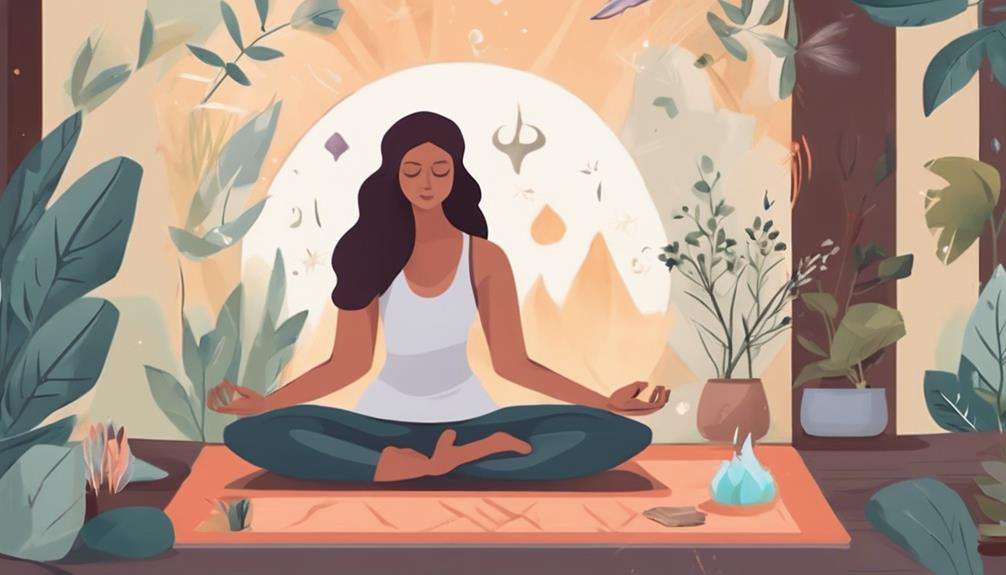When it comes to managing anxiety, have you ever considered the transformative power of yoga and meditation practices?
Incorporating these ancient techniques into your daily routine could be the key to finding relief from persistent worries and stress.
By exploring the intersection of mindfulness and movement, you might discover a path towards inner calmness and emotional balance that is both profound and sustainable.
Key Takeaways
- Yoga and meditation alleviate anxiety through mindful practices.
- Breathing techniques and pranayama enhance relaxation and well-being.
- Calm mind cultivation with meditation regulates stress response for anxiety relief.
- Yoga poses and personalized wellness plans aid in managing anxiety and promoting well-being.
Introduction to Yoga and Meditation Practices
If you're looking to explore ways to alleviate anxiety and stress in your daily life, understanding the fundamentals of yoga and meditation practices can be a valuable starting point.
For college students, especially those facing the pressures of academics and transitioning into adulthood, incorporating yoga and meditation into their routine can significantly impact their mental well-being. A study involving 17 college students aged 19-23 found that a 6-week intervention program focusing on yoga and meditation led to reduced anxiety and stress levels. Interestingly, none of the students reported high stress or anxiety post-intervention.
The participants in the study had prior experience with yoga (88%) and meditation (77%), indicating a certain level of familiarity with these practices among college students. Additionally, the mindfulness scores of the participants notably increased after the intervention, showcasing the positive effects of regular mindfulness practice on anxiety and stress levels.
Understanding Anxiety Management Techniques
When managing anxiety, utilizing breathing techniques, mindfulness practices, and grounding exercises can be beneficial tools.
These techniques help you to focus on the present moment, calm the mind, and alleviate symptoms of anxiety.
Incorporating these practices into your routine can enhance your ability to cope with stress and anxiety effectively.
Breathing Techniques
Utilizing breath-focused techniques in yoga enhances relaxation, calmness, and overall well-being for individuals seeking anxiety relief. Deep, steady breathing patterns, such as those practiced in pranayama, play a crucial role in calming the sympathetic nervous system and reducing anxiety symptoms.
Pranayama, a breath work practice in yoga, can influence heart rate variability by stimulating the vagus nerve. These specific breath practices aid in promoting relaxation and modulating the stress response, contributing significantly to anxiety management.
Mindfulness Practices
To further enhance your anxiety management toolkit, exploring mindfulness practices can provide valuable techniques for cultivating self-awareness and emotional regulation. Mindfulness practices, such as guided meditation, breath work, and yoga poses, offer effective tools for calming the mind and body during moments of anxiety.
These techniques focus on enhancing self-regulation and present moment awareness, aiding in reducing stress responses and promoting relaxation. By integrating mindfulness into your daily routine, you can experience a holistic approach to anxiety relief, improving emotional well-being and mental clarity.
Regular practice of mindfulness has been shown to decrease anxiety symptoms and increase overall feelings of calmness and inner peace. Embrace these mindfulness practices to empower yourself in managing anxiety effectively.
Grounding Exercises
Grounding exercises are essential tools for individuals managing anxiety, providing a way to connect with the present moment and alleviate distress. These practices involve sensory awareness, focusing on physical sensations, deep breathing, and mindfulness techniques.
By engaging in grounding exercises, individuals can regulate their emotions and effectively manage anxiety symptoms. Consistent practice of grounding techniques not only helps in reducing feelings of disconnection and distress but also improves overall well-being.
Incorporating these exercises into your routine can increase resilience to stress and promote a sense of calmness and stability. Remember, grounding exercises are a valuable component of managing anxiety and promoting mental wellness through techniques that anchor you in the present moment.
Benefits of Breathing Exercises for Anxiety
Breathing exercises in yoga play a crucial role in relieving anxiety by activating the parasympathetic nervous system and promoting relaxation. When you incorporate these practices into your routine, you can experience a significant reduction in stress and anxiety levels.
Here are three benefits of breathing exercises for anxiety relief:
- Lowering Physiological Responses: Controlled breathing techniques like pranayama have been shown to lower heart rate, blood pressure, and cortisol levels associated with anxiety, helping your body relax and unwind.
- Improving Oxygen Flow: Diaphragmatic breathing in yoga improves oxygen flow in the body, calming the mind and enhancing focus. This enhanced oxygenation can alleviate feelings of anxiousness and promote a sense of tranquility.
- Regulating the Nervous System: Breath work in yoga assists in regulating the autonomic nervous system, which plays a crucial role in managing anxiety symptoms effectively. By practicing mindful breathing, you can ground yourself, reduce the impact of stress, and foster a sense of calmness.
Pranayama Techniques for Calming Anxiety
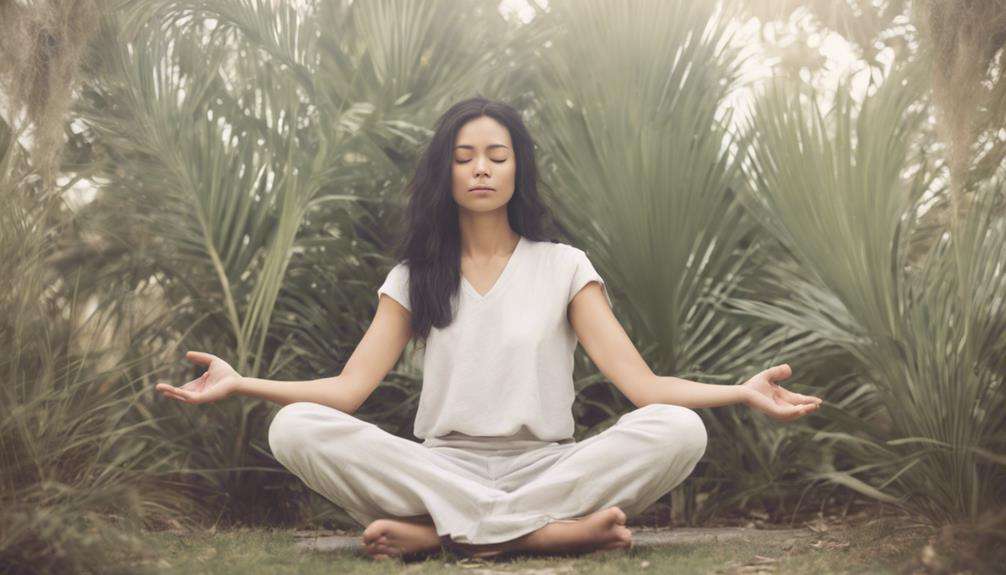
When feeling overwhelmed by anxiety, turning to your breath can be a powerful tool. Techniques like Nadi Shodhana, or alternate nostril breathing, can help regulate your nervous system and bring a sense of calm.
Breath for Anxiety
To alleviate anxiety, mastering the art of steady and controlled breathwork through Pranayama techniques in yoga can provide significant relief and promote a sense of calm. Yogic breathing techniques are powerful tools for reducing stress and anxiety, benefiting mental health.
Through deep and intentional breathing, you can engage in a practice that calms the mind and relaxes the body, helping to manage anxiety disorders effectively. By incorporating meditation and breathwork into your daily routine, you can experience a reduction in stress responses and an increase in overall well-being. This holistic approach to anxiety relief focuses on regulating your breath to influence heart rate variability and promote a state of relaxation and inner peace.
Additional Points:
- Pranayama techniques in yoga enhance focus and mental clarity.
- Consistent practice of breathwork can improve your overall well-being.
- Yogic breathing aids in calming the mind and reducing anxiety levels.
Nadi Shodhana Technique
The Nadi Shodhana technique, known as alternate nostril breathing in yoga, is a powerful practice for calming anxiety by balancing the body's energy flow. This pranayama practice involves breathing through one nostril at a time, aiming to clear the energy channels within the body.
By incorporating Nadi Shodhana into your routine, you can reduce stress and anxiety levels while promoting a sense of calm. Regular practice of this technique not only helps in calming the mind but also enhances focus and relaxation.
Calm Mind With Breath
Embrace the power of your breath to cultivate a calm mind and alleviate anxiety through the practice of Pranayama techniques in yoga. Controlled breathing can significantly help in managing anxiety by regulating the stress response and promoting relaxation.
Here are three ways Pranayama techniques aid in calming anxiety:
- Sympathetic Nervous System: Pranayama techniques involve breath control to calm the sympathetic nervous system, which is responsible for the body's fight-or-flight response.
- Effective Breath Patterns: Deep, steady breathing patterns in Pranayama have proven to be effective for anxiety relief, allowing for a more relaxed state of being.
- Vagus Nerve Activation: Pranayama influences heart rate variability through the activation of the vagus nerve, further contributing to relaxation and reduced anxiety levels.
Mind-Body Connection Through Meditation
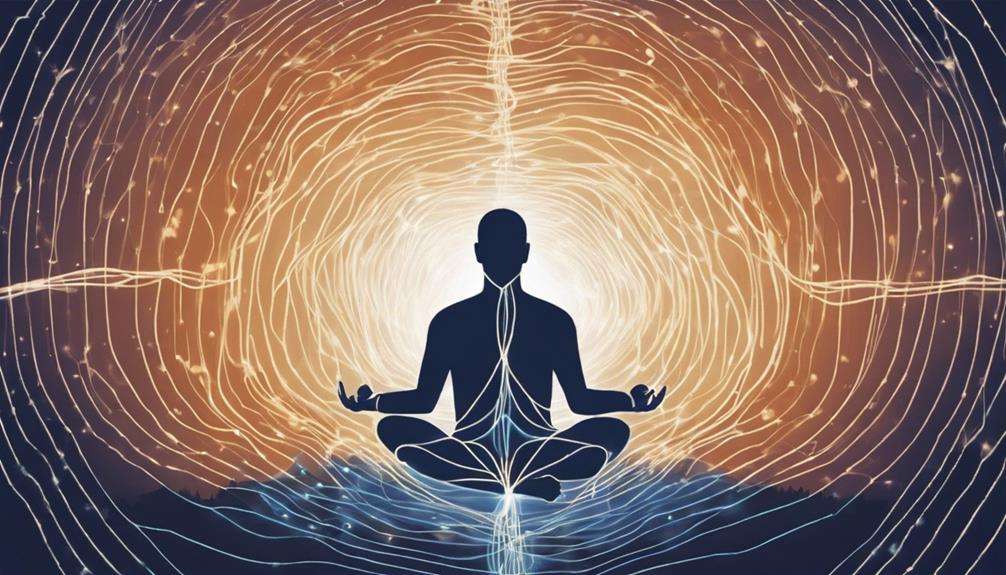
Enhancing your mind-body connection, meditation promotes self-awareness and self-regulation, offering effective relief from symptoms of anxiety and stress. By practicing meditation, you can improve your mental health while connecting with your physical body.
Through deep breaths and focused attention, meditation allows you to observe your thoughts without judgment, fostering inner calmness and reducing feelings of anxiety. The mindfulness cultivated during meditation helps you relax, stay present in the moment, and develop a deeper understanding of the connection between your mind and body.
Regular engagement in meditative practices can lead to enhanced emotional well-being and better stress management. This mind-body connection nurtured through meditation empowers you to navigate challenging situations with a sense of inner balance and tranquility.
Yoga Poses for Stress Relief
Experience relief from stress with a series of calming yoga poses designed to promote relaxation and enhance well-being. By incorporating mindful movement into your yoga practice, you can effectively reduce anxiety and stress levels.
Here are three yoga poses that are particularly beneficial for stress relief:
- Seated Neck Stretch: This pose helps release tension in the neck, promoting relaxation and stress relief. By gently stretching the neck muscles, you can alleviate built-up stress and tension in this area.
- Cat Pose and Cow Pose: These poses enhance spine flexibility and relaxation, aiding in stress reduction. The gentle flow between Cat and Cow poses can help release tension in the back and promote a sense of calm.
- Half Splits, Seated Forward Bend, Constructive Rest, Supine Spinal Twist, and Corpse Pose: These poses offer relaxation and stress relief through gentle movements. Incorporating these poses into your practice can help calm the mind and relax the body, promoting overall well-being.
Incorporating Meditation Into Daily Routine
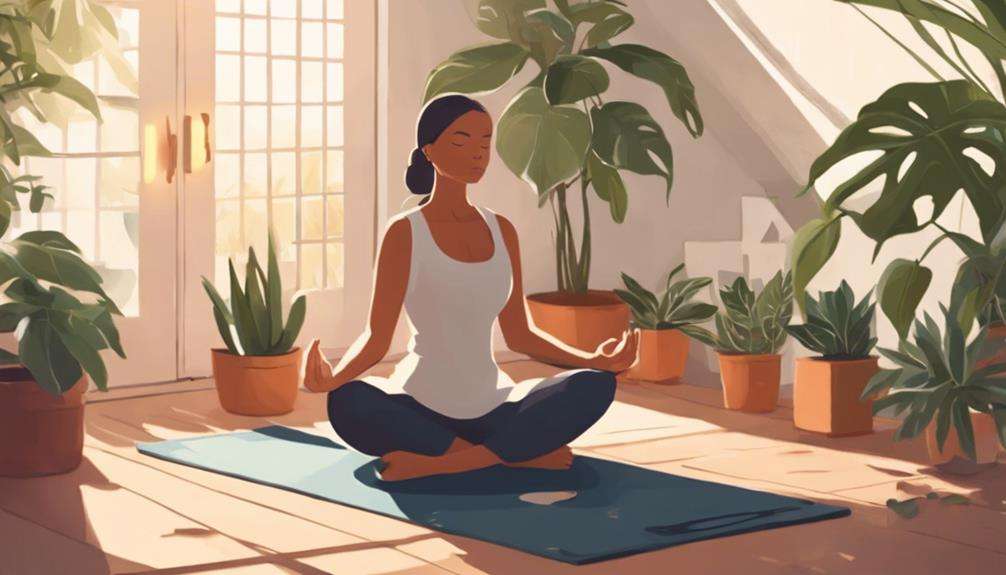
Incorporating meditation into your daily routine can significantly reduce stress and anxiety levels. By setting aside just a few minutes each day for meditation, you can experience a profound sense of calm and inner peace. Research has shown that regular meditation practice not only enhances emotional well-being but also contributes to improved overall health. Mindfulness meditation, in particular, is a powerful tool for stress management, helping you stay centered and focused amidst the chaos of daily life.
When you integrate meditation into your daily routine, you create a space for tranquility and self-reflection. This practice offers lasting benefits that extend beyond the meditation session itself, allowing you to carry a sense of mindfulness and peace with you throughout the day. By making meditation a part of your daily rituals, you can effectively manage symptoms of anxiety and other medical conditions, promoting a healthier and more balanced lifestyle. Embrace the power of meditation in your daily routine to cultivate a sense of calm and well-being.
Creating a Wellness Plan With Yoga
To create a comprehensive wellness plan integrating yoga practices effectively, consider designing a personalized routine that aligns with your individual needs and goals. Here are three essential steps to help you create a wellness plan with yoga:
- Choose a Comfortable Position: When practicing yoga, ensure you're in a comfortable position that allows you to relax and focus on your breath. This can help enhance the benefits of the poses and meditation techniques you incorporate into your routine.
- Incorporate Sun Salutations: Sun Salutations are a series of yoga poses that help build strength, flexibility, and mindfulness. Including Sun Salutations in your routine can provide a holistic approach to wellness and anxiety management.
- Attend Yoga Classes or Practice Mindfulness-Based Stress Reduction: Joining yoga classes led by certified instructors or engaging in mindfulness-based stress reduction programs can offer additional support and guidance in your wellness journey. These resources can help you deepen your practice and enhance your overall well-being.
Frequently Asked Questions
How Does Yoga and Meditation Help With Anxiety?
When you practice yoga and meditation, you engage in breathing techniques that connect your mind and body. This process reduces stress, triggers the relaxation response, fosters mindfulness, and helps you regulate your emotions, ultimately alleviating anxiety.
How Yoga Cured My Anxiety?
You experienced how yoga alleviated anxiety through its focus on breathing techniques, mind-body connection, physical movement, and the relaxation response. The practice reduced stress, brought mental clarity, and ultimately helped you find peace within yourself.
What Kind of Meditation Helps With Anxiety?
To alleviate anxiety, try mindfulness techniques for present moment awareness, deep breathing for relaxation, body scan for stress relief, loving kindness for compassion, visualization exercises for calm, and mantra repetition for tranquility.
How Meditation Healed My Anxiety?
Meditation healed your anxiety by teaching mindfulness techniques for observing thoughts without judgment, using breathing exercises to trigger the relaxation response, practicing positive affirmations, engaging in body scans for awareness, and visualization for calm.
Conclusion
As you take a deep breath in and out, imagine yourself floating on a calm, serene lake, surrounded by the gentle embrace of nature. With regular practice of yoga and meditation, you can cultivate inner peace and resilience, like a sturdy tree swaying gracefully in the wind.
Embrace these mindfulness practices as your tools for navigating the ebbs and flows of life, finding solace and strength within yourself. You're capable of overcoming anxiety with the power of your breath and presence.
